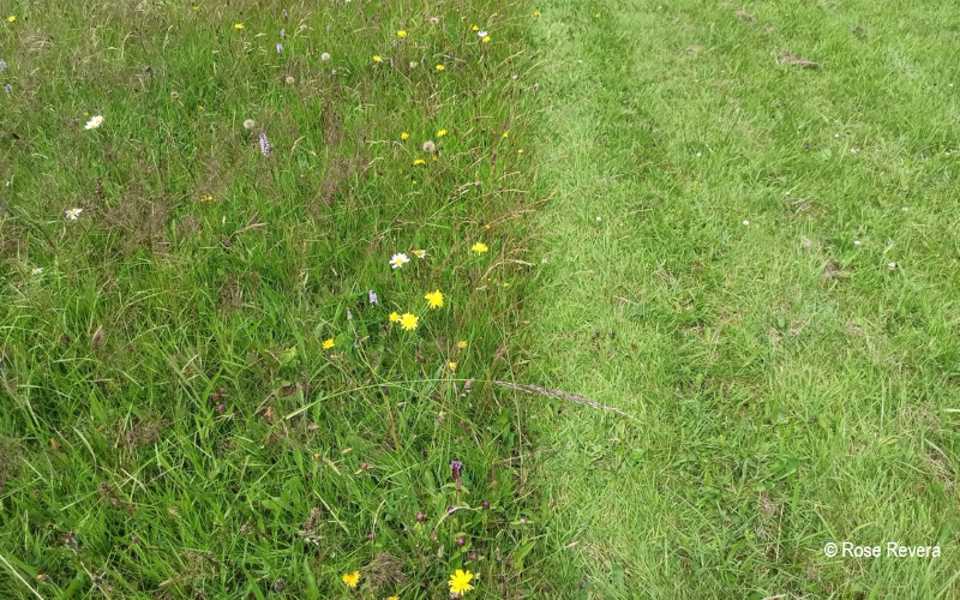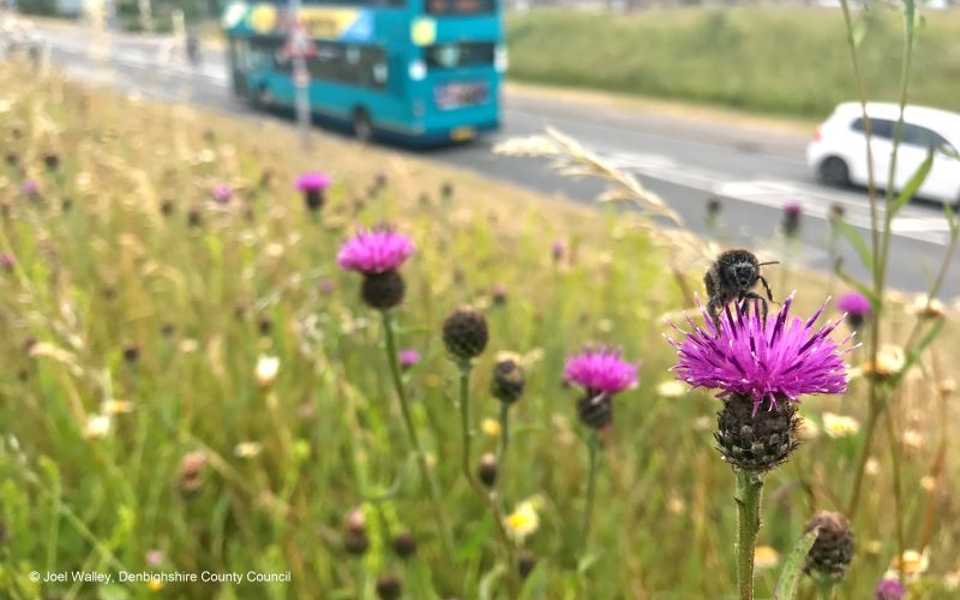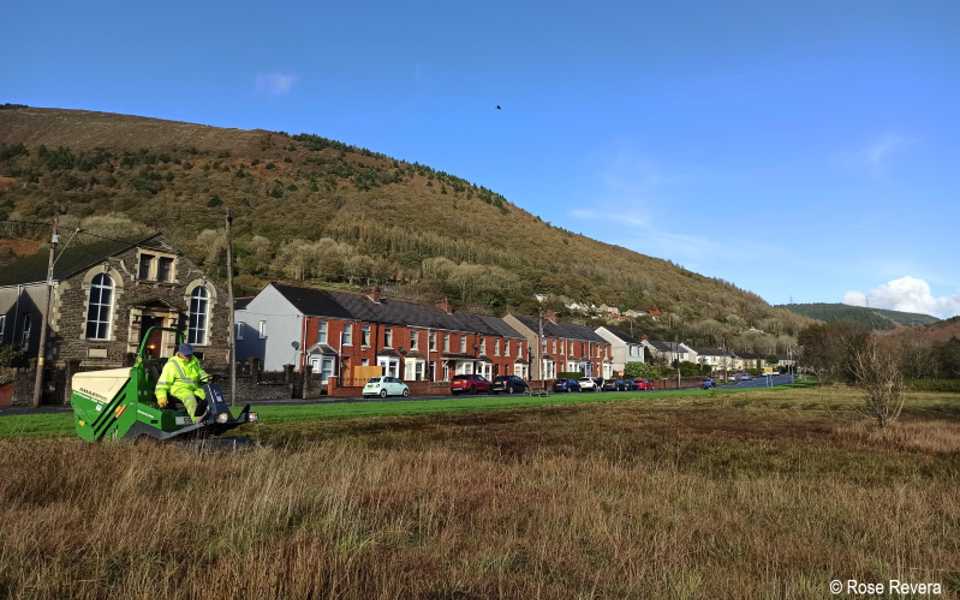Managing road verges and amenity grassland to support biodiversity.
Contents
The nature emergency
We are in a nature emergency. Our wildlife is declining and we need to act now to save it.
We can make road verges and amenity grasslands (parks and other open green spaces) more wildlife friendly. Regularly cut, closely mown grass may look tidy but it has little benefit for wildlife. Letting grass grow and having more meadow-like areas with wildflowers helps wildlife.

Animals and plants benefit from having meadow-like green areas
Plants
Wildflowers, including rare wildflowers, grow and produce seeds, allowing them to increase year-on-year.
Invertebrates
Wildflowers and grasses provide food for insects, including:
- bumblebees
- hoverflies
- beetles
- butterflies
- moths
- grasshoppers
Long grass gives shelter to lay their eggs and complete their life cycles. Meadow soils contain high numbers of earthworms.
Mammals
Bats, field mice, voles, shrews and hedgehogs eat the plants and invertebrates found in meadows.
Amphibians
Frogs and toads feed on invertebrates.
Reptiles
Slow-worms and lizards also eat invertebrates, and grass snakes eat frogs.
Birds
Small birds like goldfinches eat seeds from wildflowers. Other birds such as swallows and swifts eat insects. Kestrels, buzzards and barn owls feed on small mammals.

Changing how we cut grass is about saving wildlife not reducing costs
Changing how we cut grass can create more native wildflower meadows. Even if some of these patches are small, it will all add up to a big area. Wildlife will be able to move between wildflower habitats as they become connected.
Road verges and amenity grasslands: supporting people
As well as supporting wildlife, people enjoy seeing wildflowers. The COVID-19 pandemic has shown us the importance of nature for our wellbeing. It has also highlighted the need to reverse the decline in biodiversity.
Many people know that trees and peatlands can store carbon. This can help us to combat the climate emergency. It is less well known that soils in grassland can also store carbon. Species-rich grassland stores more carbon than species-poor grassland. Having species-rich meadows:
- along our roadsides
- in parks, and
- in green spaces
can help us combat both the Nature and Climate Emergencies.
Mowing less often stops soil becoming too compacted. Looser soils allow plant roots to develop better. This helps soil absorb water and reduces the impacts of flooding and drought.
Who Manages Road Verges and Amenity Grasslands?
We work with Trunk Road Agents to look after our trunk road and motorway network. Trunk roads and motorways are very busy roads. They connect major cities, towns and ports. The M4, A470 and A55 are a few examples. More information about verges on the trunk road and motorway network is available.
Local authorities manage most other road verges. Verges around villages and in residential areas may be looked after by:
- community and town councils, and
- housing associations
Publicly-owned amenity grassland is looked after by:
- local authorities
- community and town councils
- housing associations, and
- community groups
Under the Environment (Wales) Act 2016, public authorities must maintain and enhance biodiversity. Sympathetic mowing of road verges and amenity grasslands can help meet this duty.
Organisations who set out their grassland management priorities promote action:
- through corporate support and management plans
- by committing to the Bee Friendly scheme
This encourages workforces to work together and to adopt new approaches.
Plantlife has produced managing grassland road verges: a best practice guide (see resources section on https://roadverges.plantlife.org.uk). This was in collaboration with partners including ourselves.
Nature isn’t Neat (on monlife.co.uk) has developed a code of action. This includes alternative ways to manage grasslands.
Cut and collect
Cut and collect is a method that copies traditional ways of managing hay meadows. It involves collecting grass cuttings (arisings) after mowing. This is important because it:
- prevents the build-up of dead vegetation, which can smother delicate plants
- leaves more exposed ground to allow seeds to grow
- reduces soil fertility, slowing the growth of nutrient-loving coarse grasses that choke wildflowers and finer grasses

Road safety
It is also important that we keep roads safe for users. For visibility, we will need to manage certain areas to ensure safety. We may cut these more often:
- junctions
- verge edges
- roundabouts
Our support for changes
Local Places for Nature is our initiative to create nature on your doorstep. It offers capital grants to buy equipment such as cut and collect machines. These help public sector organisations to:
- change their mowing practices
- expand the areas where they can enhance biodiversity
Since 2021, all local authorities in Wales benefitted from this support. They are changing their mowing practices. We want more organisations to get involved to create more meadows for wildlife.
Local Places for Nature continues to improve grassland areas for biodiversity. It provides funding for capital projects for not-for-profit land managers in Wales, for example:
- local authorities
- community and town councils
- housing associations
- schools
- NHS
- others who manage not-for-profit grassland
For more information, contact your LNP coordinator. They have valuable expertise and knowledge. They can give advice on how to increase nature in local communities.
The Local Places for Nature Officer, Rachel Carter supports Community and Town Councils. Rachel provides advice and support to access funding. She also offers general support on biodiversity plans.
It’s for Them
‘It’s for Them’ is a campaign that aims to increase awareness that changing mowing is about saving wildlife.
Reducing mowing on road verges and amenity grasslands creates a better habitat for ‘Them’:
- wildflowers
- invertebrates
- birds
- mammals
- amphibians
- reptiles
If you manage road verges or amenity grasslands, we would like you to get on board. We need your support to make ‘It’s for Them’ a success. We have created a stakeholder toolkit with assets for you to use. Add your own logos and details to:
- infographic template
- printable sign templates
- short leaflet with a some frequently asked questions
We would like your help to spread the word about ‘It’s for them’. The stakeholder toolkit includes suggested social media messaging. Please share social media posts with your networks. With your support, we can encourage more people to reduce mowing and help save our wildlife.
Case studies
Many local authorities and other organisations across Wales are changing how they manage their grasslands. Be inspired by:
- Denbighshire Wildflower Project (on arcgis.com)
- Torfaen turns tide on mowing regime (on torfaen.gov.uk)
- Treasured natural habitat curated by Bron Afon (on bronafon.org.uk)
- Cardiff volunteers help to manage parks for nature (on outdoorcardiff.com)
- Plantlife Cymru: From Green to Gorgeous (on YouTube)
- Buglife Cymru B-lines: Stryd Y Brython, Ruthin - Enhancing verges and public green spaces for pollinators by changing management
- Buglife Cymru B-lines: Ysbryd y Môr in Port Talbot - Enhancing verges and green spaces for pollinators with natural regeneration
